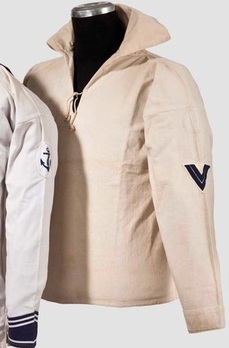Kriegsmarine Drill Shirt
CATEGORY: Version
SKU: 21.GOR.02.01.05.004.000
Estimated market value:

Estimated market value:
The headgear, uniforms, and insignia worn by members of the Kriegsmarine were based upon the designs utilized by the Kaiserliche Marine (Imperial Navy) and the Reichsmarine (Navy of the Weimar Republic). The official regulations governing the uniforms of the Reichsmarine were issued on April 5, 1921, and they were embraced, with a few alterations, as the Kriegsmarine uniforms in 1935.
From 1933 to 1945, the uniforms worn by personnel in the German Navy were produced and disseminated by the Navy Clothing Depot and private manufacturers. The cloth was of a high quality prior to the Second World War, but during the war, it became increasingly synthetic and of lower quality. Similarly, the cloth used in the uniforms of Officers and Admirals was of a higher quality than the cloth used in the uniforms of lower ranking personnel, such as Non-Commissioned Officers and Enlisted Men. The cloth utilized in garments of the blue uniform is of an overall better quality than the cloth utilized in the field-grey uniform. For the field-grey uniform specifically, the cloth is more grey-coloured in pre-war uniforms, while the cloth is more green/olive-coloured in wartime uniforms.
The main colour of Kriegsmarine uniform pieces is a dark navy blue. However, during the summer months, and initially also in regions with warmer climate, a white summer uniform was used. Eventually, a brown tropical uniform was introduced for units stationed in tropical and subtropical regions. Land-based Kriegsmarine units, most of which were part of the Coastal Artillery, wore Army-like field-grey uniforms in the style of the Kriegsmarine.
The garments may have proof stamps, serial and unit stamps, and manufacturer marks denoting the legitimacy and origin of the item. They also tend to feature sewn name tabs (Namensläppchen) on all clothing items associated with the blue and field-grey uniforms. The blue uniform garments all have a serial number stamp (Stammrollennummernstempel), while the field-grey uniform garments have a unit stamp.
The proof stamp is present on all garments produced by the Navy Clothing Depot, and it includes the size of the item, if needed, with the year of manufacture above the size, and a surmounting script that reads “B.A.K.” or “B.A.W.”. This stamp information is framed, and written in white ink on blue or black garments and in black ink on all other colour garments.
The serial stamp is composed of letters and numbers, and it is present on blue uniform garments from the Depot. The stamp is either printed in red ink or sewn in red thread. The numbers are preceded by a letter that denotes the area in which the wearer served, with an “N” for Navy Station or an “O” for Navy Station Baltic. The stamp ends in a letter associated with the wearer’s career group, with an “S” for deck personnel and a “T” for technical professionals. Below the serial number is the year in which the wearer entered the navy, surmounted by a horizontal line.
The unit stamp is present on field-grey uniforms. It includes the framed, shortened unit name of the wearer in red ink.
The marks of private manufacturers vary widely, ranging from codes to full names, and even abbreviated letters, as well as the year of manufacture. After 1942, Reich numbers (Reichsbetriebsnummern) were also used as manufacturer marks (RB-).
The buttons worn on Kriegsmarine garments are generally gold-coloured, except for the uniforms of Officials which used silver-coloured buttons. The buttons feature the image of a fouled anchor on the obverse. The buttons are composed of brass, or of light metal. The gold-coloured buttons were gilded, while the silver-coloured buttons were silvered. As well, in the case of special uniform garments the buttons may be composed of plastic.
The Drill Shirt or Work Shirt was originally worn by Enlisted Men and Junior Non-Commissioned Officers as part of their general attire while shipboard, at barracks, or performing drill duties. In February 1940, it was decided that Junior Non-Commissioned Officers should wear the blue Jumper Shirt instead of the Drill Shirt.
This shirt is composed of several main elements, including the collar, the blue shirt collar, the neckerchief, the slash and ribbons, the pocket, and the career insignia.
These shirts may be composed of white cloth, or after 1940, from field-grey coloured cloth, and it fell to approximately 50-100mm below the waistline of the wearer.
The shirt collars are composed of two layers of rectangular basic cloth that is attached to the neck. The blue shirt collar was often worn over the shirt collar, and the neckerchief was only worn when explicitly ordered. See the Blue Shirt Collar section for more information.
The front of the shirt features a “V” slash, which is lined in basic cloth along the edges, and has two sections of 350mm white ribbon along either side to close the slash. The sleeve cuffs also feature small slashes, which are closed by a small zinc button. The cuffs are reinforced with basic cloth.
The patch pocket is located on the right breast of the shirt with a horizontal opening.
To start, only Junior Non-Commissioned Officers were permitted to wear career insignia on the field blouse, but after 1940 the insignia could also be worn on the left sleeve of Enlisted Men.

Comments
Sign in to comment and reply.


Scroll Top